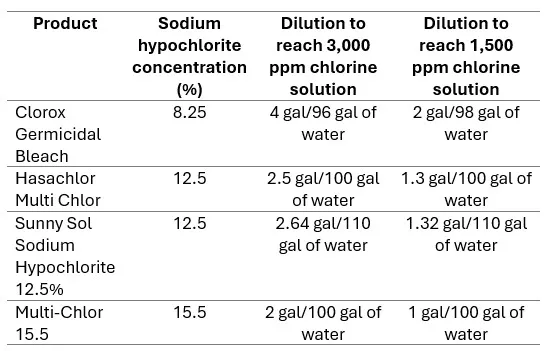Chlorine Seed Treatments

In the last month, I’ve had more frequent calls about how to cut costs, with several people mentioning cutting their chlorine seed soak treatment in an attempt to bring down their input costs. This seed soak is used to eliminate bakanae spores from rice seed and is one of the most effective methods to prevent widespread bakanae infestations in rice fields.
As we get ready to plant for the 2025 season, it’s important to talk about why the chlorine (sodium hypochlorite) seed soak solution is vital to reducing the amount of fungal inoculum available to infest rice fields.
What is bakanae?
Bakanae is a disease that is caused by the fungus Fusarium fujikuroi, which causes overproduction of the plant hormone gibberellin and the mycotoxin fusaric acid. In normal quantities, gibberellin stimulates cell elongation and regulation of plant stature; however, the excess production of the hormone results in a plant that is overly elongated, spindly, and chlorotic. As the plants mature, the crown of the plant will rot, and most plants will die prior to producing a panicle. If a panicle is produced, the kernels will not fill.
Bakanae was first discovered in California in 1999. Since then, it has spread across the state's rice-growing areas. Initially, the disease posed a significant threat to the rice industry, leading to reduced yields in heavily affected fields. However, after the introduction of sodium hypochlorite as a seed treatment, the disease became less of a concern, with losses occurring only rarely. In recent years, though, its significance has increased again due to a decrease in the use of chlorine seed treatment.
How does bakanae spread?
At field maturity, the pathogen will produce pink sporulation on dying tillers, which can infest seeds of nearby plants and fields during harvest. Bakanae is usually classified as a seed-borne disease, meaning that the spread of the disease occurs primarily via seed and seed coats. In basmati fields in India, survival of Fusarium fujikuroi in field soil was detected several months post-harvest (An et al, 2024); however, infested soil is not considered a major source of bakanae inoculum.
There is evidence that the pathogen can be hosted by several different grass species besides rice, including some species of watergrass. However, it is not known if this occurs in California (Hsuan et al, 2011).
What is the best way to prevent bakanae?
Using a chlorine solution as a seed treatment is the most effective method for eliminating bakanae spores from the seed. A chlorine solution is a mixture of chlorine, typically in the form of sodium hypochlorite (often referred to as bleach), dissolved in water. Seed treatment with a registered sodium hypochlorite product is effective at reducing the incidence of this disease and may be performed at either 3,000 or 1,500 parts per million (ppm) available chlorine.
For the 3,000 ppm chlorine solution:
- Dilute sodium hypochlorite in water to prepare a 3,000 ppm chlorine solution, soak seed for 2 hours, drain, and then soak in fresh water until ready for seeding.
For the 1,500 ppm chlorine solution:
- Alternatively, seed can be soaked in a 1,500 ppm chlorine solution for at least 24 hours without the need to drain and soak in fresh water before seeding.
To prepare the chlorine solution, use only registered sodium hypochlorite products and follow the instructions on the label. Products have different concentrations of sodium hypochlorite and therefore the amount of product needed to reach the right chlorine concentration varies. An example of registered products as of the writing of this Fact Sheet is shown in Table 1.

Seed should be sown within 12 to 24 hours of draining. When seed is held for longer, temperature in the holding tank increases and any surviving bakanae spores will germinate and produce more spores, resulting in seed that is infested even though it was treated.
How expensive is the chlorine treatment?
According to the 2021 UC Rice Production Cost Study, the total pre-plant costs for seed delivery to field (in a conventional, water-seeded system) approximate $62 per acre; however, that price includes the cost of the seed, the delivery, and the aerial application: all practices that would be performed in a regular water-seeding practice, and therefore should not be considered as additional costs. The study estimates that the chlorine seed soak treatment costs approximately $4 per acre. The cost studies are an approximation of costs, and your numbers may vary, but the chlorine solution cost is a very small part of the overall seed delivery expense.
What are the options for organic, drilled, or dry-seeded rice growers?
Currently, no effective seed treatments against bakanae exist for organic, dry, or drill seeded rice. Given that most of the acreage in California is conventionally grown and water seeded, wide adoption of the chlorine seed treatment can reduce the areawide bakanae inoculum and reduce the overall risk of infection and contamination of seed for organic, drilled, and dry-seeded rice. For further information about bakanae in rice, refer to the UC Rice bakanae fact sheet.
